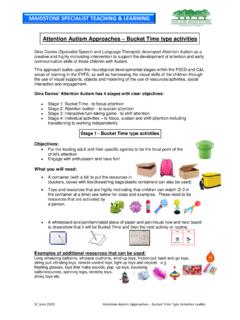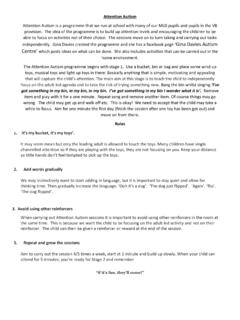Transcription of A Bucket F ull of Ideas - St Patrick's Primary School ...
1 SENISS Special Educational Needs and Inclusion Support Service 1 | P a g e A Bucket Full of Ideas A booklet of activities to support parents to continue to develop their child s early attention , engagement and turn taking skills, whilst home schooling during COVID-19 Based upon the principles and 4 stage structure underpinning the attention autism Approach (Gina Davies) SENISS Special Educational Needs and Inclusion Support Service 2 | P a g e Contents Introduction .. 3 Stage 1 .. 4 Stage 2 .. 6 Stage 3 .. 14 Stage 4 .. 21 Example 8 week schedule .. 28 Simple doh 29 Useful video examples .. 30 SENISS Special Educational Needs and Inclusion Support Service 3 | P a g e Introduction Parents/Carers, We have gathered some general guidance and FUN activity Ideas in which to help you to support your child at home.
2 The principles and structure underpinning the activities are based upon The attention autism Approach. Practitioners in many settings across the city have adopted this approach, in order to develop early focus, engagement and turn-taking skills, in young people with autism . In settings, additional adults are encouraged to sit with the children to offer support, model reactions and engagement. This may be difficult to replicate at home. However, if there is an extra adult or an older child available, it would be helpful if they could provide similar support. We have included some general guidance for each stage of the programme, an example 8 week schedule, with activity guidance, examples of resources and some useful video links which demonstrate the different stages of attention autism .
3 We hope you will find it useful, engaging and fun! About attention autism attention autism is an approach to support young people with autism . It was designed by Gina Davies, Specialist Speech and Language Therapist. It aims to develop natural and spontaneous communication through the use of visually based and highly motivating activities. Gina s Primary objective is that the sessions are fun and offer an irresistible invitation to learn ! There are four distinct phases to the programme: Stage 1 - The Bucket Stage Stage 2 - The attention Builder Stage 3 - Turn Taking and Re-engaging Stage 4 - Shifting & Re-engaging attention NB - The activities are designed to be fun and engaging. Be forewarned they can get MESSY! We would advise using a cheap shower curtain (or craft sheet) to protect surfaces.
4 We have included a MESSY STAR rating system to help guide you, 1 star * being least messy, 2 ** being a bit Messy and 3 **, being very messy! SENISS Special Educational Needs and Inclusion Support Service 4 | P a g e Stage 1 The Bucket Stage The first stage teaches children to focus their attention on the adult-led agenda quickly. We want the children to be irresistibly drawn to the Bucket and its contents The Bucket is a non-see-through container/bag, that holds a selection of small objects such as; wind-up, pop-up, musical or mechanical toys the children will find visually appealing, but which they have never seen before. Novelty value is key, so you need to build up a collection of lots of different items to maintain the element of surprise. During this difficult time , you may need to be creative and adapt/decorate general household items such as sunglasses, hats, kitchen rolls, plastic bottles, containers etc.
5 To create visually stimulating items and musical instruments. Environment - clear the environment of distractions and seat your child opposite you. Structure- In keeping with good visual communication practice, you start by drawing a Bucket on a little whiteboard or piece of paper and write Bucket underneath. Then you set the scene by singing the Bucket song before taking the lid off the Bucket and pulling out one of its secrets. Language - Try to keep your language to a minimum at this point because you want your child to look at the object, pay attention to it and engage with visually. You will be looking at it also and so you will all have the same-shared experience. For example, you might just say, Light spinner when you bring it out of the Bucket . Then you put it back in the Bucket and pick out something else.
6 It takes maybe two or three minutes to do three objects in a row. Then you say: It s finished, sign finished and cross the Bucket off on the board and move on to whatever else the children were doing. It might be helpful to follow the Bucket activity with a favourable activity such as snack. Rules Don t be tempted to hand the toys/objects over to your child, they must remain special. Likewise, avoid including anything in the Bucket that your child already possess and love playing with. Imagine the distress of a child, whose special interest is Peppa Pig, when they sees their favourite toy held up in front of him, but out of bounds! SENISS Special Educational Needs and Inclusion Support Service 5 | P a g e Stage 1- attention Focus Ideas Bucket time - choose 2-3 objects to hide in a Bucket /bag Resource Ideas bubbles, balloons, windup toys, push and go toys, musical toys, jack in the box, light spinners, foam rockets, musical instruments, funny glasses, party blowers, party hat, party popper, funny mask, pop up toy, pop up puppet, rice shaker etc.
7 During this time it may be necessary to make some of the resources yourself such as pop up puppets/toys, sock puppets, using a kitchen roll to make noisy shakers or decorate existing glasses, hats etc. Directions Sing the Bucket song, I ve got something in my Bucket , in my Bucket , in my Bucket , I ve got something in my Bucket I wonder what it is? (to the tune of here we go round the mulberry bush) Gradually reveal 2-3 visually stimulating items from the Bucket . Replace the lid each time . Then say finished and put the Bucket away and cross off the Bucket picture on your wipe board/paper. MESSY RATING 1* SENISS Special Educational Needs and Inclusion Support Service 6 | P a g e Stage 2 The attention Builder After anything from five to ten Bucket Full of Surprises, your child should be ready for stage 1 and Stage 2, the attention builder.
8 This involves introducing a longer activity that stretches their attention span for up to 10 minutes. It has a clear beginning, middle and end and is fascinating to watch from start to finish. Environment as before, clear the environment of distractions and seat your child opposite you. Structure - you start by splitting the wipe board in two. Draw a Bucket on one side as before and a second activity on the other side. Deliver Bucket time as in previous sessions and then cross it off your board. Language continue to keep your language to a minimum because you want your child to watch the activity, pay attention to it and engage with it visually. Sharing your experience. Name the object sieve, flour etc. and the actions. For example you might just say shake, shake, shake as you sprinkle the flour.
9 Example Activity Draw a face - you might have a basket containing a box of flour, a sieve and a piece of black paper and a plain shower curtain to put the paper on. You draw on the board and write flour shaking . Then you unroll the paper, open the box and scatter flour from a height all over the paper. Then you draw a face on it. Finally, you tip the flour back into the box and start the whole process all over again. You might do that three times, and then you say, It s finished. Cross the activity off on your wipe board. If your child wants to join in, that s great, because it means they are engaged. But you gently tell them, It s XXXX s turn , and they accept this, because they have become used to the idea that your role is to show them things while theirs is to relax and enjoy watching.
10 SENISS Special Educational Needs and Inclusion Support Service 7 | P a g e Stage 2 attention Building Ideas Flour shapes & stencils Resources flour, stencils can be everyday objects or card cut outs, sand moulds, paper, sieve Activity place stencils on paper, sprinkle flour over the top and remove the stencil to reveal the shape. (Alternatives to flour include; glitter, sand, snow, etc.) MESSY RATING 1* Flour Face Resources paper, sieve, flour Activity Sprinkle flour from a height onto the paper. Say, Shake, Shake, Shake . Draw a face in the flour naming the features such as eyes, nose, mouth etc. (Alternatives include; drawing lines, shapes, letters, numbers, flowers, animals etc. Alternatives to flour are; sand, glitter fake snow, dry rice, shaving foam spayed and smoothed) MESSY RATING 1* Flour Castles Resources four cups, piece of paper, flour.

